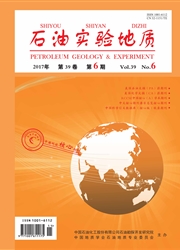

 中文摘要:
中文摘要:
通过对四川盆地川西坳蹈中生界非常规致密砂岩气藏的研究,认为物性盖层的遮盖能力不仅取决于其孔隙,还取决于其缝隙及其孔隙水的压力。对辽河西部凹陷第三系油气藏的研究发现,欠压实超压封盖是一种非常有效的封盖,并将盖层分为微孔型、微缝型和欠压实超压型3种类型.提出应用饱和度与对应毛细管压力的比值,即主峰饱压比,作为区分微孔氆和微缝型盖层的参数。盖层的孔隙水异常压力常常是由泥岩欠压实形成的,与通常的泥岩遮盖机理并不相同,欠压实泥岩盖层在埋藏浅一中等的地层中具有重要作用,对于浅层气更加重要。微孔型盖岩的发育可以导致封存箱的形成,在埋藏中等一深的地层中最为重要,也是最常见的具封存和遮挡作用的盖岩类型。异常压力系统是具有一定体积的地质体,根据其成因可分为封闭型(封存箱)、滞排型(与欠压实有关的超压带)、顶封滞排型和入侵型4种类型。根据异常压力和压力遮盖封闭研究,勘探的优先目标是一大(体积大)、一高(压力系数高)、一低(压力梯度低)的封存箱或封存包,或者是欠压实滞排超压带压力遮盖闭合区主遮盖面的紧下方.可概括为异常压力系统封存或遮盖聚集油气,也简称为超压封盏油气的理论认识。
 英文摘要:
英文摘要:
Based on studies of the Mesozoic unconventional tight sandstone gas reservoirs in the western depression of the Sichuan Basin, it was found that sealing capability of caprocks depends on not only micropores, but also fractures and pore fluid pressures. Researches of the Tertiary oil and gas reservoirs in the western depression of the Liaohe Basin proved that undercompacted mudstones worked as effective overpressure sealing for hydrocarbon accumulations. Therefore, eaprock seals were divided into 3 types: mieropores, micofractures and undercompacted ones with overpressure sealing. A new parameter (the ratio of oil saturation to its corresponding capillary pressure) was used to distinguish microfracture caprocks from micropore ones. Abnormal pressure sealing of pore fluid was usually caused by mudstone undercompaction, which was radically different from normal micropore sealing mechanism of compacted mudstone. The undercompacted mudstone sealing played an important role in shallow-medium buried accumulations, especially in shallow gas accumulations. Development of micropore caprocks might bring about the formation of compartments which took place in medium-deep buried horizons, and affected hydrocarbon migration and accumulation greatly. According to their origin, abnormal pressure systems were divided into 4 types: the sealed (compartments), the expulsiondelayed (overpressure zones related to undercompacted mudstones), the top-sealed and expulsion-delayed, and the invaded. Based on researches of abnormal pressure and overpressure sealing, it was concluded that the optimal targets of exploration were the compartments with huge volume, high pressure coefficient and low pressure gradient, as well as the traps immediately below main overpressure sealing surfaces of undercompacted zones. These concepts are summarized as abnormal pressure sealing controlling hydrocarbon accumulations.
 同期刊论文项目
同期刊论文项目
 同项目期刊论文
同项目期刊论文
 Formation mechanism of carbonate cemented zones adjacent to the top overpressured surface in the cen
Formation mechanism of carbonate cemented zones adjacent to the top overpressured surface in the cen 期刊信息
期刊信息
